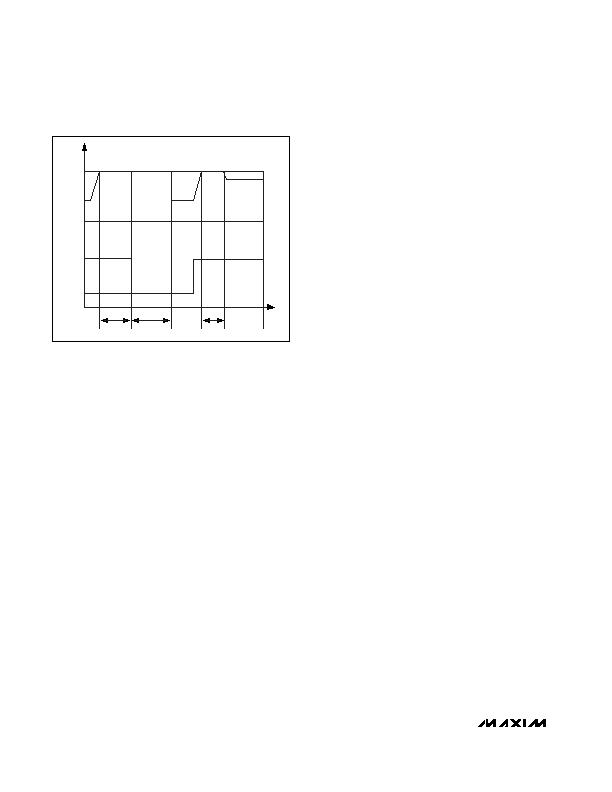
+60V Simple Swapper Hot-Swap Switch
10 ______________________________________________________________________________________
Output Clamping During Short Circuit
During an output short-circuit condition, the energy stored
in the output capacitor is dumped onto the short and
builds up a large current in the power path and its para-
sitic inductance. The larger the output capacitor, the larg-
er the current buildup. The parasitic inductive current
circulates through the short circuit and brings OUT below
ground level. A Schottky diode is needed at the output to
provide the path for this circulating current and to prevent
OUT from going too far below ground and exceeding the
MAX5923s absolute maximum ratings.
For an output capacitor with low ESR (ceramic and film
type), and with values of 0.47礔 or less, a B1100LB
(100V, 1A Schottky) is required as shown in the Typical
Application Circuit. For higher values of capacitance,
more robust clamping is required. For applications using
aluminum electrolytic capacitors, which have relatively
high ESR, the requirement of the clamp diode is reduced.
Good layout with less parasitic trace inductance also
helps in reducing the clamping diode requirement and
should be examined on a case-by-case basis.
Power-OK (POK)
POK goes open-drain t
POK_HIGH
(88ms) after V
OUT
rises to within 0.75V (V
THPOK
) from V
IN
. POK goes low
t
POK_LOW
(1.4ms) after V
OUT
drops 0.75V below V
IN
.
Zero-Current Detection
Zero-current detection is enabled if ZC_EN is high and
only after the startup period has finished (indicated by
POK going high). When V
SENSE
falls below the zero-
current threshold (V
ZCTH
) for a continuous t
ZCDEL
=
350ms, a zero-current fault is generated. The MOSFET
is turned off and ZC is latched low. ZC is open drain
during initial power-up. After a zero-current fault has
occurred, the MAX5923 is latched off and is restarted
by applying a low-to-high transition on the EN pin.
At any time during a zero-current condition, if V
SENSE
goes above V
ZCTH
for the zero-current deglitch time
(t
ZC_DEG
= 10ms), the zero-current counter resets to
zero and a zero-current fault is not generated. Bring
ZC_EN low to disable the zero-current detection func-
tion. ZC stays high impedance in this mode.
Thermal Shutdown
If the MAX5923 die temperature reaches +150癈, an
overtemperature fault is generated. The MOSFET turns
off and FAULT goes low. The MAX5923 die tempera-
ture must cool down below +120癈 before the overtem-
perature fault condition is removed (see the Fault
Management section).
Fault Report (FAULT)
FAULT goes low when there is an overcurrent fault and/or
an overtemperature fault. FAULT is open drain otherwise.
After a fault, the FAULT signal is latched low. FAULT is
unlatched at the beginning of the next power mode.
Fault Management
The MAX5923 offers either latched-off or autoretry fault
management configurable by the LATCH input.
Bringing LATCH high puts the device into latch mode
while pulling LATCH low selects the autoretry option.
In latch mode, the MAX5923 turns the MOSFET off and
keeps it off after an overcurrent fault or an overtemper-
ature fault. After the fault condition goes away, recycle
the power supplies or toggle the EN pin low and high
again to unlatch the part. However, the part waits a
t
RESTART
period (1.92s) before recovering from a fault
condition and resuming normal operation.
In autoretry mode, MAX5923 turns the MOSFET off after
an overcurrent or overtemperature fault. After the fault
condition is removed, the device waits a t
RESTART
period
(1.92s) and then automatically restarts. If the fault was
due to an overtemperature condition, the MAX5923 waits
for its die temperature to cool down below the hysteresis
level before starting the t
RESTART
time.
t
OC
t
RESTART
t
<
t
OC
t
0V
V
FAULT
0V
I
OUT
I
LIMIT
Figure 3. Periodic Overcurrent Without Generating a Fault
发布紧急采购,3分钟左右您将得到回复。
相关PDF资料
MAX5926EEE+
IC HOT-SWAP CONTROLLER 16QSOP-EP
MAX5929BEEG+
IC HOT SWAP CTLR QUAD 24QSOP
MAX5930AEEG+
IC HOT SWAP CTLR PWR SEQ 24QSOP
MAX5932ESA+T
IC HOT-SWAP CONTROLLER 8-SOIC
MAX5933EESA+
IC HOT-SWAP CONTROLLER 8-SOIC
MAX5934EEE+
IC HOT-SWAP CONTROLLER 16-QSOP
MAX5935EAX+
IC CTRLR POWER QUAD 36-SSOP
MAX5937LCESA+
IC HOT-SWAP CTRLR -48V 8-SOIC
相关代理商/技术参数
MAX5923EUP-T
功能描述:热插拔功率分布 RoHS:否 制造商:Texas Instruments 产品:Controllers & Switches 电流限制: 电源电压-最大:7 V 电源电压-最小:- 0.3 V 工作温度范围: 功率耗散: 安装风格:SMD/SMT 封装 / 箱体:MSOP-8 封装:Tube
MAX5924AEUB
功能描述:热插拔功率分布 RoHS:否 制造商:Texas Instruments 产品:Controllers & Switches 电流限制: 电源电压-最大:7 V 电源电压-最小:- 0.3 V 工作温度范围: 功率耗散: 安装风格:SMD/SMT 封装 / 箱体:MSOP-8 封装:Tube
MAX5924AEUB+
功能描述:热插拔功率分布 1-13.2V Hot-Swap Controller RoHS:否 制造商:Texas Instruments 产品:Controllers & Switches 电流限制: 电源电压-最大:7 V 电源电压-最小:- 0.3 V 工作温度范围: 功率耗散: 安装风格:SMD/SMT 封装 / 箱体:MSOP-8 封装:Tube
MAX5924AEUB+T
功能描述:热插拔功率分布 1-13.2V Hot-Swap Controller RoHS:否 制造商:Texas Instruments 产品:Controllers & Switches 电流限制: 电源电压-最大:7 V 电源电压-最小:- 0.3 V 工作温度范围: 功率耗散: 安装风格:SMD/SMT 封装 / 箱体:MSOP-8 封装:Tube
MAX5924AEUB-T
功能描述:热插拔功率分布 RoHS:否 制造商:Texas Instruments 产品:Controllers & Switches 电流限制: 电源电压-最大:7 V 电源电压-最小:- 0.3 V 工作温度范围: 功率耗散: 安装风格:SMD/SMT 封装 / 箱体:MSOP-8 封装:Tube
MAX5924BEUB
功能描述:热插拔功率分布 RoHS:否 制造商:Texas Instruments 产品:Controllers & Switches 电流限制: 电源电压-最大:7 V 电源电压-最小:- 0.3 V 工作温度范围: 功率耗散: 安装风格:SMD/SMT 封装 / 箱体:MSOP-8 封装:Tube
MAX5924BEUB+
功能描述:热插拔功率分布 1-13.2V Hot-Swap Controller RoHS:否 制造商:Texas Instruments 产品:Controllers & Switches 电流限制: 电源电压-最大:7 V 电源电压-最小:- 0.3 V 工作温度范围: 功率耗散: 安装风格:SMD/SMT 封装 / 箱体:MSOP-8 封装:Tube
MAX5924BEUB+T
功能描述:热插拔功率分布 1-13.2V Hot-Swap Controller RoHS:否 制造商:Texas Instruments 产品:Controllers & Switches 电流限制: 电源电压-最大:7 V 电源电压-最小:- 0.3 V 工作温度范围: 功率耗散: 安装风格:SMD/SMT 封装 / 箱体:MSOP-8 封装:Tube